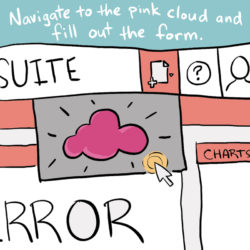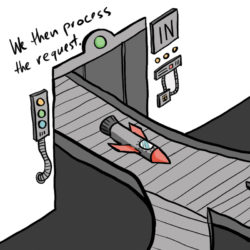Businesses are responsible for paying their financial obligations while keeping in touch with customers who still have outstanding debts. Although this may seem overwhelming for an accounting department, many companies divide these tasks into two segments.
Accounts payable and receivable manage the money that flows in and out of the organization so financial advisors can accurately gauge your financial stability. In this article, you’ll learn more about Accounts Payable vs Accounts Receivable how they differ, and how to make your Accounts Payable and Accounts Receivable processes as efficient as possible.
What are Accounts Payable (AP)?
Accounts payable is the process of managing, organizing, and paying your company’s outstanding accounts. In other words, it is all the financial obligations assumed by your business. Paying your organization’s suppliers and human resources on time is an example.
To ensure the smooth running of the business, a company needs to interact with service providers, suppliers, and other audiences to hire human resources and obtain services and products. In this sense, having good account management is essential for it to fulfill its commitments and avoid financial losses.
PREVIOUS POST — The OdeCloud Vision For The NetSuite Community Is Coming To Life.
When reading the concept of this strategy, it seems like a very simple process: just organize the slips, pay attention to the due date of each one and pay them on the correct date, right? This dynamic exists, but the accounts payable sector has an even greater responsibility.
In addition to having to align with an established financial plan, organizing accounts payable involves understanding the company’s financial health and its ability to invest and assume new debts/costs.
In this way, accounts payable is not just a strategy to settle a company’s debt every month. This is a process that helps an organization achieve the goals defined in its growth plan, such as expanding its business.
Classification of Accounts Payable (AP)
Accounts payable are classified according to the maturity time agreed with the creditor:
· Short-term accounts payable: these correspond to current liabilities that must be paid within a year from the acquisition of the debt. There are even payments that are made monthly to daily.
· Long-term accounts payable: These are also non-current liabilities; the payment is made in a period greater than one year.
For this, specific data must appear in the accounts payable:
· Name of the biller, the provider to whom the debt is owed
· Company account number
· Invoice number helps ensure accurate accounting
· Type of expense the nature of the good or service purchased
· Invoice receipt date
· The payment term allows that time delays and charges for it are not generated.
· Status if the invoice has been paid or is pending payment
RELATED POST — Building A Freelancing Platform for Digital Nomads
What Are the Accounts Payable of a Company?
Accounts payable can be very varied, such as:
· Payment to suppliers for merchandise or products purchased.
· Wages to pay
· Rent payment
· Services provided by third parties such as electricity, water, gas, heating, internet, etc.
RECOMENDED POST — Just In Time Inventory: Keep Inventory Stocked Without Overspending
Accounts Payable Process Steps
-
- Receipt of the invoice: When goods or services are purchased, the company receives a physical or electronic invoice that contains information such as the name of the item, amounts, etc.
-
- Review of the detail of the invoice: In it, you will find data such as the name of the supplier, date, amounts, and number of items purchased, among others.
-
- Updating and validation of the records: These must be completed based on the values contained in the invoices received and may require approvals and consultations with internal systems. If they are physical invoices, they are stored in the corresponding place.
-
- Payment Made: All payments made to the provider within the established due date. A series of documentation is required, such as purchase orders, and bank account information, among others.
NEXT POST — NetSuite Workflows: How to Automate Your Business Processes
Tips to Improve Accounts Payable Management
Here are some tips that may be useful to improve the administration of your company’s accounts payable:
Maintain a Balance Between Your Income and Expenses
From the outset, this point might sound quite obvious. However, it is important always to keep it in mind and ensure that the level of expenses equals the income the business receives. This is to be able to keep finances healthy and prevent too many debts from accumulating in the future to such an extent that the management of accounts payable gets out of hand, making it impossible to pay them and, therefore, other serious consequences such as the cessation of operations of the business.
Choose Your Suppliers Beyond Price
When choosing the suppliers with which a company wants to work, most of them can be carried away by the price factor. However, consider the different payment conditions offered by each one since having more flexible conditions can be more beneficial than having lower prices.
Take Advantage of the Payment Terms Offered by Suppliers
And organize the payment of your invoices based on the above so that you can prioritize those with a term closest to expiration.
Maintain Good Communication With Your Suppliers
On some occasions, your company cannot comply with the timely payment of an invoice. For this type of case, it is suggested that you notify the supplier in advance and explain the situation so that you can negotiate another payment date.
PREVIOUS POST — NetSuite Inventory Management: Everything You Need To Know
Seek to Negotiate With Suppliers to Obtain Discounts for Early Payment
Paying early, when you have the possibility, not only contributes to a good relationship with suppliers but also gives you the opportunity to obtain early payment discounts, which can positively impact cash flow.
Check That Your Suppliers Meet Their Commitments
You must confirm that each supplier is complying on time with the previously agreed commitments. For example, certain products are delivered on the established date, in the quantity requested, and in good condition. Otherwise, make the corresponding return or claim.
Set Payment Alerts or Reminders
This helps you remember the dates on which you must carry out the corresponding transactions of the various invoices. These do not have to be physical, but some technological tools give you the opportunity to have them digitally and automatically.
Automates and Standardizes the Management of Accounts Payable
It keeps track of cost and expense invoices under a standardized form. It is also advisable to manage these invoices by cost centers and projects for greater ease.
RELATED POST — Automated Intercompany Eliminations: Simplify Your Close Process with NetSuite
Accounts Payable and NetSuite ERP
NetSuite ERP (Enterprise Resource Planning) is a cloud-based business management software that contains all the processes for managing accounts payable, from invoicing and tracking to payment processing.
NetSuite’s Accounts Payable module helps automate invoice approval workflow, eliminate manual data entry errors, gain visibility into vendor balances and payment status, and handle purchase orders and expenses.
Thanks to this software, it is possible to reduce the time spent on administrative tasks related to accounts payable, maintain control over the company’s cash flow and have greater certainty of what has been paid or will have to be paid in the future.
RECOMMENDED POST — Simple Guide to NetSuite Grid Order Management
Benefits of Automating Accounts Payable Process
Undoubtedly, including technology in the day-to-day of companies allows greater productivity and efficiency when managing accounts payable and digital expenses.
We will tell you about the benefits of automating the AP process and their importance for companies.
Connection Between Documents or Departments
By having the processes automated through a system, the possibility of carrying out more effective traceability of all the documents is created to know, in this way, all those elements that may be related to accounts payable, such as invoices, credit notes, or debit, dispatch guides, payments, expiration dates, and credits, among others.
In addition, today’s solutions allow all members of accounts payable management or those in charge of this area to view all the information on the same platform in real time. Thus, they can perform their tasks more efficiently.
Availability of a Portal for Suppliers
There are specific software or systems that allow providers to access their platforms to find out the payment status of an invoice or any other information generated around it by their own means, improving customer service times. And it reduces the work of those in charge of finances to answer calls, questions or claims to take advantage of it in developing strategies and actions that improve the accounts payable processes.
This way, the provider will always be informed about your pending account, what is left to be collected or if any payment was generated.
Error Reduction
Automating the billing and document reception processes facilitates the approval of payments to suppliers since the information can be verified quickly and simply if the data is correct.
This allows a more accurate recording and monitoring of invoices and, consequently, the reduction of possible errors such as the payment of double invoices, the disregard of credit notes, the verification of errors in amounts or amounts issued by the supplier and the fraudulent income invoices, inaccurate figures, among other actions.
NEXT POST — NetSuite SuiteBilling – Billing the way you want it
Likewise, when the company needs to carry out expense audits, the possibility of detecting errors is reduced: having all the information centralized and stored in a single platform makes it easier to carry out this procedure and increases the accuracy of the data.
On the other hand, the solution reduces employees’ workload when carrying out this type of management.
Execution of Punctual Payments
When an automated control of accounts payable is carried out, it is less likely that there will be delays in payments due to carelessness, ignorance, or loss of documents since each of the invoices will be registered and will have payment reminders according to their expiration date.
These platforms or software streamline processes and enable options for authorization or approval of payments, in addition to providing the possibility of automating the automatic sending of the same so that the cost to the supplier is made on the indicated date. In short, the process is easier and faster to do.
Prepare Financial Reports in Seconds
Accounts Payable Automation allows reports to be obtained with just a few clicks, providing timely information to help make better decisions when needed.
Thanks to the elaboration of these reports, it is possible to obtain data referring to the economic situation of a company, the total accumulated debts, the documents pending payment, the movement of cash flow, or any other element of expenses in general.
In this way, it is also possible to determine if a business has sufficient resources to meet pending obligations. On the contrary, it needs to search for and obtain other alternatives as potential sources of financing, which facilitates more effective cash flow management.
What Are Accounts Receivable (AR)?
Accounts receivable are the most frequent payment mechanism when carrying out a transaction between parties. Whether for services or goods. The economic system usually works on the basis of money to be collected and not on the liquidity or cash that may exist at the time of making a payment. This form of payment is called Accounts Receivable.
The Financial Information Standards define an account receivable as an exigible right by the entity to collect a consideration as a transaction for the satisfaction of an obligation acquired and fulfilled by the provision of a service or the sale of goods.
Accounts receivable typically show the debit balance on the company’s balance sheets. These are a host of rights in favor of the company against another or third parties. It arises from the provision of services or the sale of goods. In other words, accounts receivable come from the company’s periodic economic operations.
PREVIOUS POST — OdeCloud Aiming to Become Leader in NetSuite-Related Content
How Do Accounts Receivable Affect the Business?
Accounts Receivable, as explained before, are future receipts that the company will have arising from payments in installments or with a future payment date.
Therefore, the enterprise’s financial planning needs to be aware of this account so that it can be assembled in the most efficient way.
Accounts receivable directly affect the company’s decision-making regarding making investments or assuming expenses because this capital is available in the future and not in the present.
Some types of credit, working capital loans, for example, can accept accounts receivable as a form of guarantee.
When the venture arrives in this situation, it may be because of poor planning.
Therefore, the company must be in control of when these future payments will be made to be aware of the commitments it may or may not assume.
RELATED POST — How to Setup NetSuite Billing Schedules
Accounts Receivable and Decision-Making
At the time of decision-making on matters relating to the company’s financial matters, it is necessary to know accounts receivable to understand the guarantees the company has in the future and the commitments that can be assumed.
Nowadays, using credit cards has become commonplace for many of the population.
Therefore, companies must be prepared for this scenario and plan to control the payment of their costs and expenses in the same period the capital is received.
In addition, there are many other advantages, such as:
-
- Identify good and bad payers;
-
- Make payment management more efficient;
-
- Offer a cash estimate for subsequent months;
All these analyses are extremely important for the decision to be the most appropriate for the company’s scenario, avoiding unpleasant surprises in the future, which can often lead the enterprise to fragile situations.
RECOMMENDED POST — NetSuite Consultant: Why You Need One for Your Business
Characteristics of Accounts Receivable
These accounts act as a kind of credit or loan to a client. The different elements and characteristics of accounts receivable are defined in the invoice:
-
- Expiration date or collection period
-
- account amount
-
- Payment method
-
- Client data
NEXT POST — NetSuite SuiteSuccess: Accelerate Your Company’s Growth
Types of Accounts Receivable
Accounts receivable should be part of a business’ accounting from a business and accounting standpoint. The collection term is essential since it defines the type of account receivable. Thus, accounts can be classified into two types:
-
- Short-term: Those that require immediate availability within less than one year. These accounts must be presented in the financial statement as current assets.
-
- Long Term: Its availability is more significant than one year. These types of accounts must be presented as fixed assets.
PREVIOUS POST — NetSuite Accounting: Simplify Your Financial Reporting
Managing Your Accounts Receivable
Even though it is an essential requirement, controlling accounts payable and receivable is occasionally imprecise, even in large companies. It may seem simple, but it requires constant monitoring and a certain amount of pragmatism.
Establish Effective Billing Processes
Errors when capturing prices, names and concepts can cost your company dearly. On the one hand, it means a more significant investment of time and money; on the other, the inconvenience with your clients will be resolved. Therefore, having an efficient billing system is a priority need.
Keep Your Customer Database Updated
Centralizing your clients’ information in a single place is essential to maintain the correct accounts receivable management. Having incorrect contact information can cause problems when sending an invoice, which will cause the invoice to be redone, resent to the indicated client and delay the receipt of payments. You would waste a lot of time and money!
Define Credit Approval Processes
Sometimes, to increase your client portfolio and sales, you can create the bad habit of granting credit left and right, which seriously affects your business finances. We want to tell you that giving credit to one of your clients is okay, but you must be very careful since there must be an adequate process to grant it.
RELATED POST — What is a NetSuite Developer?
Perfect Your Payment Application Process
This rule is one of the most important in any company: as soon as you receive a payment, apply it to the corresponding account in your register! This will allow you to differentiate at all times the accounts that are current from those that are already expired.
Optimize Your Collection Processes
The above points will help make your collection process more organized and straightforward. When payments are applied correctly, it is much easier to determine which accounts are at risk of failing to meet the payment dates.
Invest in Technology
To avoid loss of productivity, you can invest in technologies that optimize processes. With this, you put into practice a dynamic flow of information that is beneficial for decision-making.
Accounts Receivable and NetSuite
NetSuite ERP is an ideal tool for managing accounts receivable. This solution automates one system’s billing, credit review, collections, and customer service processes.
In addition, it helps reduce errors by having all the information centralized and automating tasks associated with Accounts Receivable. By implementing NetSuite, you will be able to control all your finances in a single platform.
In conclusion, Accounts Receivable management must be taken seriously because it affects the financial health of any business. Knowing how to receive payments and optimize collection processes can make a massive difference in cash flow and customer relationships.
Investing in technology like NetSuite can also optimize your processes and make financial operations easier. With a good Accounts Receivable management strategy, any business will have a greater chance of success.
RECOMMENDED POST — NetSuite SuiteCommerce: My Secret to Ecommerce Success
Accounts Payable vs Accounts Receivable
Accounts payable and accounts receivable are two components of a company’s balance sheet. Accounts payable is the total amount of money your business owes to its suppliers, while accounts receivable is the total amount owed by customers for goods or services provided.
The distinction between these two types of accounts lies in their purpose: Accounts payable exist to reduce debt, while accounts receivable exist to increase sales.
The accounts payable vs accounts receivable difference also lies in their relationship. Accounts payable describes the amount of money that you owe, while accounts receivable reflects the amount that customers owe your business.
This means that when a customer pays for goods and services provided, it will show up as an increase in accounts receivable and a decrease in accounts payable. On the other hand, when you make payments to suppliers for goods and services, it will show up as an increase in accounts payable and a decrease in accounts receivable.
The importance of understanding the difference between these two types of accounts cannot be overstated. Properly managing your company’s accounts payable and receivable is key to maintaining a healthy cash flow. As such, it is important to invest in technology that can help you better manage these accounts and ensure that your company’s finances are well managed.
With the right tools, you can improve efficiencies within your business’s Accounts Receivable and Payable departments and ensure that your customer and supplier relationships are managed effectively.
NEXT POST — Work Remotely and Travel the World: The Perks of Being a Freelancer
Conclusion
Accounts payable (AP) and accounts receivable (AR) are two important aspects of any business. In this guide, we’ve outlined the basics of each process and what you need to know in order to effectively manage your company’s finances.
Contact us at OdeCloud today if you’re looking for more information or to discuss implementing AP/AR into your business. We specialize in helping businesses like yours get set up with the right financial software, so you can focus on what you do best – running your business. Thanks for reading!









36 Responses
1
Discover Bwer Pipes: Your Source for Quality Irrigation Products in Iraq: Bwer Pipes offers a wide selection of irrigation solutions designed to meet the diverse needs of Iraqi agriculture. Whether you need pipes, sprinklers, or accessories, we have everything you need to enhance your farm’s productivity. Learn More